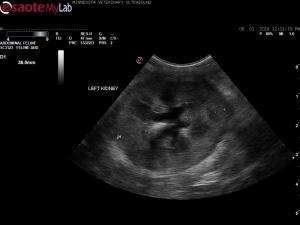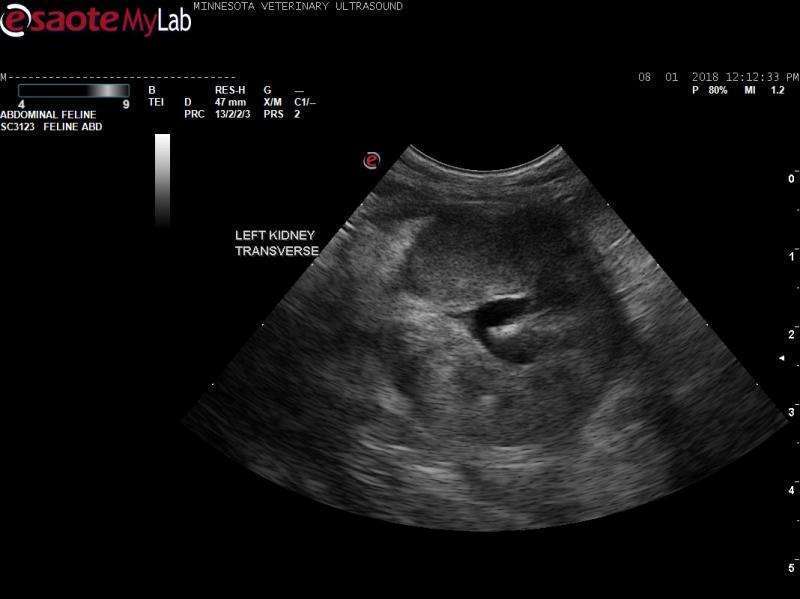- 12 year old FS DSH presented for anorexia and mammary gland nodule.
- Primary vet palpated and radiographed an enlarged left kidney.
- CBC and chems are wnl.
- Cat was placed on Clavamox and appetite has returned.
- Abdominal US done today shows a normal size left kidney with mild to moderate pyelectasia (4.1mm), clumping, perirenal echogenic fat, and highly echogenic density at the renal sinus.
- Rule outs include pyelonephritris, ureteral stricture or obstruction, and neoplasia
- 12 year old FS DSH presented for anorexia and mammary gland nodule.
- Primary vet palpated and radiographed an enlarged left kidney.
- CBC and chems are wnl.
- Cat was placed on Clavamox and appetite has returned.
- Abdominal US done today shows a normal size left kidney with mild to moderate pyelectasia (4.1mm), clumping, perirenal echogenic fat, and highly echogenic density at the renal sinus.
- Rule outs include pyelonephritris, ureteral stricture or obstruction, and neoplasia
- What are your thoughts? Owner does not want to pursue mammary gland nodule removal without reassurance that the left kidney is not neoplastic.


Comments
I would be leaning torwards
I would be leaning torwards pyelonephritis in your patient. The hyperechoic perirenal fat is very significant. There are hyperechoic flares in the medulla which can represent regions of localised infection. The renal crest is hyperechoic. This is best evaluated when the crest is imaged facing down perpendicular to the far field ( pointed downwards ). This eliminates some artifacts that could be formed as hyperechoic streaks as the sound beam reflects off the aligned collecting tubules within it.You want your sound beam to be parallel to the collecting tubules. In your case, it is the whole crest that is hyperechoic making it more likely to be real. Finally the walls of the renal pelvis and proximal ureter seem thickened without a biopsy or FAN. All these fit best with pyelonephritis but as you know are not 100% definitive.
I like the pyeleonephritis
I like the pyeleonephritis idea here but what is concerning to me is the capsular escape at 11 o’clock in video 1 and the subcapsular halo in video 2. I annotated the images here from screen shots. I am concerned with emerging LSA here and would fna 25 g for sure. LSA and pyelo can live together as well.
Might be a good one to try
Might be a good one to try the RI value on?
Thank you for your thoughts.
Thank you for your thoughts. I performed an FNA on the kidney and the results came back as:
“Atypical population of somewhat cohesive cells. A pleomorphic carcinoma or an anaplastic sarcoma is strongly suspected.”
So glad that I did the fna as I was also leaning more towards pyelonephritis.
Well done and interesting
Well done and interesting case. Eric, nice comments about capsular escape, brilliant observation. The part that bothered me was the hypoechoic bands associated with the hyperechoic fat ( halo as you described) . I couldn’t tell if it was fluid or cellular. Fluid would have fit better with a pyo and cells with neoplasia. The other part that wasn’t a good fit for pyelonephritis was the lack of echogenic debris in the pelvis fluid. I still think that this is a good case for RI just to help put it to rest. Excellent case.